- Visibility 420 Views
- Downloads 78 Downloads
- Permissions
- DOI 10.18231/j.jchm.2023.033
-
CrossMark
- Citation
Patient’s satisfaction with the treatment provided in Basrah Dental College between July 2022 and April 2023
Abstract
Objective of the Study: This study aimed to assess patients' satisfaction with the dental care provided by undergraduate students, identify factors affecting satisfaction with the treatment, and gather recommendations for improving dental services.
Materials and Methods: An observational study was conducted at the University of Basrah College of Dentistry between the first of July 2022 and the first of April 2023. The study involved patients who consented to participate and provided written informed consent. Ethical clearance was granted by the institution's Ethics Committee, and 348 participants were randomly selected from dental clinics to respond to the questionnaire.
Result: Forty per cent of the study participants were aged between 20-29, with 146 (41.9%) being male and 202 (58.1%) being female. One hundred and sixty-six (33.3%) of the patients were housewives, 324 (92%) were low to moderate-income earners, and 199 (57%) lived in the city center, while 149 (42.8%) lived in district and subdistrict areas. Two hundred and forty (68.9%) of patients felt that the treatment was either cheap or too cheap. Regarding the waiting room, patients were generally satisfied with all aspects except for the waiting time, with 290 (83.3%) finding it too long. An average of 88.3% of patients were satisfied with the treatment provided by the students, but only 64.4% were satisfied with the length of the treatment period. Only 28 (8%) of patients experienced postoperative complications, with 13 related to dental treatment and 12 expected. Additionally, 24 patients reported their complications to the students, while 12 patients experienced unexpected complications. Finally, 45.4% of patients returned to the college for further treatments.
Conclusion: While the patient expressed dissatisfaction with the long waiting and treatment times, most respondents expressed satisfaction with the treatment received, but improvements are necessary in certain areas.
Introduction
Patients visit the dentist for a variety of reasons, including pain relief, routine oral health checks, aesthetic improvement, and, frequently, full-mouth rehabilitation for restoration of normal function. Accessibility, practicality, and cost are factors that patients consider while choosing dental clinics or dental hospitals for their care. While the majority of dental clinics assist patients with their dental issues, dental teaching colleges and affiliated hospitals are the preferred option for comprehensive dental treatments because of their reputation, price, and doctors' professional skills. [1], [2]
Dental colleges serve as educational institutions, and it is mostly the students who provide patient treatment while being supervised by knowledgeable staff. Clinical training professors are very concerned with the necessity to teach students how to give patients high-quality dental care. Dental colleges serve a sizable portion of the population due to lower treatment prices and a perception of high-quality care, despite the difficulties in scheduling appointments and lengthy clinical settings. Therefore, it is crucial to instils in dentistry students strong standards of professional behavior [3], [4]
It is widely acknowledged that a successful dentistry practice cannot be developed without assuring patient satisfaction and that the outcome of a satisfied patient, thus, determines the quality of a hospital or clinic.[5] This will undoubtedly depend on the quality of dental care and services offered, on confidentiality, on the accuracy of appointments, and the conduct of the personnel. [6]
Enhancing patient satisfaction in dental clinics requires effective communication between patients and dental professionals. More likely to be satisfied with their care are patients who feel that they are being heard and understood. Effective communication between patients and dental professionals enhances patient satisfaction and treatment outcomes, according to a study that was published in the Journal of Dental Education.[7]
Another important element that significantly affects patient satisfaction in dental clinics is empathy. Patients want to believe that the people caring for their oral health and meeting their requirements care about them. Dental practitioners who are compassionate are more likely to build rapport and trust with patients, which increases patient satisfaction. A comprehensive review in the Journal of Dentistry found that compassionate behavior and communication among dental workers increase patient satisfaction.
In dental clinics, technical proficiency is a crucial component that affects patient happiness. Patients want to believe that the people caring for their oral health are competent, skilled, and capable of delivering high-quality care. Technically skilled dental workers are more likely to inspire patients' confidence, which will increase patient satisfaction. Technical proficiency is a crucial element in patient satisfaction with implant implantation, according to a study published in the Journal of Oral and Maxillofacial Surgery.[8]
Patient satisfaction at dental clinics is significantly impacted by access to care, which is another important element. Patients want to believe that they can get the care they need when they need it and quickly. Patients are more likely to be satisfied with dental offices that offer convenient scheduling and simple access to care. A study in the Journal of the American Dental Association found that access to care is essential for determining how satisfied patients are with their dental care.[9]
This study tries to measure and put in figures the level of fulfilment and approval of dental services delivered by the College of Dentistry, exactly with mention to these important aspects of awareness.
Objective of the study
This study aimed to assess patients' satisfaction with the dental care provided by undergraduate students, identify factors affecting satisfaction with the treatment, and gather recommendations for improving dental services.
Materials and Methods
A cross-sectional analytical observational study was conducted at the University of Basrah College of Dentistry over a period between the first of July 2022 to the first of April 2023. Patients who voluntarily consented to participate in the study provided written informed consent, the institution's ethics committee granted ethical clearances, and 348 participants were chosen randomly from the dental clinics to respond to the questionnaire. Inclusion criteria included both sexes (males and females) who have started their dental treatment at the Basrah dental clinic. Patients who did not receive any dental treatment at Basrah Dental Clinic or refused to participate in this study were excluded from the study.
As part of the data collection procedure for the study, patients filled out a paper questionnaire that sought to ascertain their level of satisfaction with the dental services provided by Basrah Dental College. Age (divided into groups: under 19, 20-29, 30-39, 40-49, 50-59, and above 60) years, gender, nationality, address (divided to the city center, districts and sub-districts), occupation includes (housewife, students, workers, and employers), and income divided according to the monthly income to (under 500000 IQD, between 500000-1500000 IQD, and above 1500000 IQD) are socio-demographic aspects that are also considered in the study. The questionnaire also examined the following seven primary dental service disciplines:
Biographic data and visit triggers
Reasons for visiting Basrah College of Dentistry include six equations
A Waiting period, which involved four questions
The examination session There are seven questions
Cooperation among dental students, including 12 questions
The postoperative period includes five questions
The price of care
Microsoft excel was used to list the answers to the questions that were obtained before SPSS version 29 was used to analyze it.
Result
Biographic data and visit triggers
A total of 348 patients were selected for the study all of whom were Iraqis nationality. Totaling (41.9%) males and (58.1%) females. The category of patients aged under 20 and between 20 -29 years has the highest proportion of patients (72) 20%, followed by the category with ages 40 to 49, then ages 30-39, ages 50 to 59 and ages greater than 59 (figure 1). In terms of occupation, 116 (33.3%) of the respondents were housewives, followed by 60 (17.2%) workers, 46 (13.2%) employers, 22.1% students, and 49 (14.1%) who did not respond ([Figure 2]). Most of the responses, 187 (53.7%), were under 500000 IQD; 137 (39.4%) were between 500000 and 1500000 IQD; 20 (5.7%) were over 1500000 IQD; and 4 (1.1%) did not respond ([Figure 3]).
Patients from the city center are 199 (57.2%) more than those from districts and sub-districts 149 respondents (42.8%) ([Figure 4]). Most patients (124/35.6%) asked for conservative treatments, followed by 91 (26.1%) who needed tooth extractions, 85 (24.4%) who needed periodontal therapy, 39 (11.2%) who needed prosthodontic services, 9 (2.6%) who need other services ([Figure 5]). Patients overwhelmingly rated the cost of therapy as "too cheap" in 132 cases (37.9%), "cheap" in 108 cases (31.0%), "suitable" in 95 cases (27.3%), "no answer" in 8 cases (2.3%), and "expensive" in 5 cases (1.4%) ([Figure 6]) ([Table 1]).
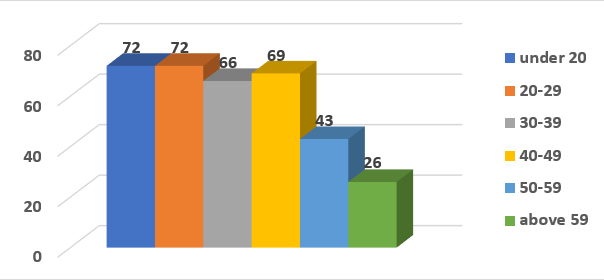
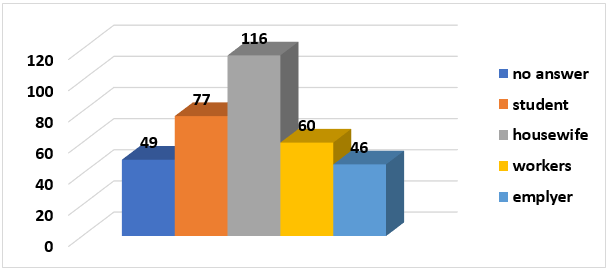

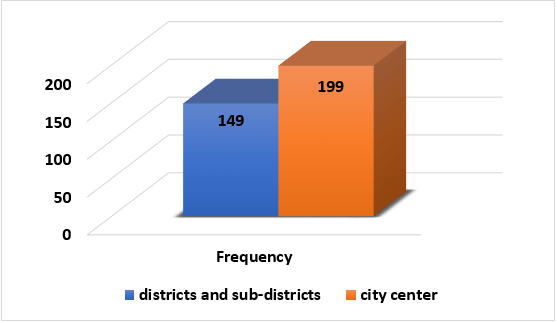
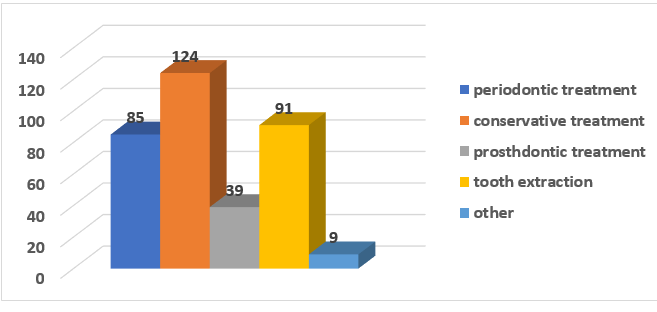
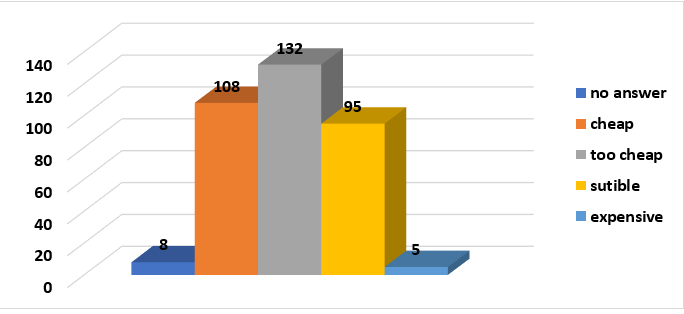
|
Data |
Answer |
Frequency |
Per cent |
|
Gender |
Male |
146 |
41.9 |
|
Female |
202 |
58.1 |
|
|
Age groups |
under 20 |
72 |
20.7 |
|
20-29 |
72 |
20.7 |
|
|
30-39 |
66 |
19.0 |
|
|
40-49 |
69 |
19.8 |
|
|
50-59 |
43 |
12.4 |
|
|
above59 |
26 |
7.5 |
|
|
Occupation |
no answer |
49 |
14.1 |
|
student |
77 |
22.1 |
|
|
housewife |
116 |
33.3 |
|
|
Workers |
60 |
17.2 |
|
|
employer |
46 |
13.2 |
|
|
Income |
>500000 |
187 |
53.7 |
|
<1500000 |
20 |
5.7 |
|
|
500000-1500000 |
137 |
39.4 |
|
|
No answer |
4 |
1.1 |
|
|
Address |
districts and sub-districts |
149 |
42.8 |
|
city center |
199 |
57.2 |
|
|
Type of the treatment |
periodontics treatment |
85 |
24.4 |
|
conservative treatment |
124 |
35.6 |
|
|
prosthodontic treatment |
39 |
11.2 |
|
|
tooth extraction |
91 |
26.1 |
|
|
other |
9 |
2.6 |
|
|
Treatment costs |
no answer |
8 |
2.3 |
|
cheap |
108 |
31.0 |
|
|
too cheap |
132 |
37.9 |
|
|
suitable |
95 |
27.3 |
|
|
expensive |
5 |
1.4 |
Why people go to Basrah College of Dentistry
Six questions make up the portion. 157 patients (27%) believe the treatment is inexpensive. 119 patients (21%) felt the treatment was effective. Due to its proximity to their homes, 66 (11%) of the patients were selected to receive treatment at Basrah Dental College. 95 patients (16%) feel that the appointments are near, while 36 (6%) say that there is no need for conversion. Due to a lack of services at the nearby health center, 110 patients (19%) decided to receive treatment at the college ([Table 2]).
|
Why do people go to Basrah College of Dentistry |
Frequency |
Per cent |
|
Treatment is very cheap |
157 |
27% |
|
Treatment is good |
119 |
21% |
|
Close to the residence |
66 |
11% |
|
Not need conversion |
36 |
6% |
|
Appointments are close |
95 |
16% |
|
Lack of service at the nearby health center |
110 |
19% |
The waiting periods
Most of the patients 270 (77.6%) mention how comfortable and spacious the waiting room is, whereas 221 (63.5%) of patients believe there are enough employees, whereas 271 (77.9%) feel the working system is well-organized. 290 (83.3%) feel the waiting duration is too long ([Figure 7]) ([Table 3]).
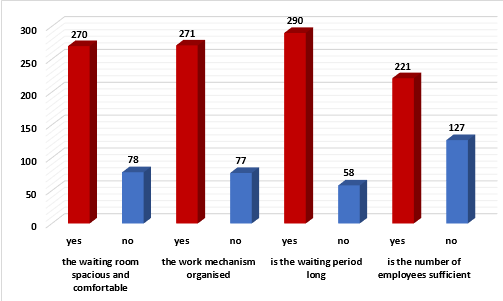
|
Question |
Answer |
Frequency |
Per cent |
|
Is the waiting room spacious and comfortable? |
yes |
270 |
77.6 |
|
no |
78 |
22.4 |
|
|
Is the working mechanism organized? |
yes |
271 |
77.9 |
|
no |
77 |
22.1 |
|
|
Is the waiting period long? |
yes |
290 |
83.3 |
|
no |
58 |
16.7 |
|
|
Is the number of employees sufficient? |
yes |
221 |
63.5 |
|
no |
127 |
36.5 |
Examination period
Patients were satisfied with questions related to the examination period and missed rates between 70%-90% as shown in the table. ([Table 4]).
|
Question |
Answer |
Frequency |
Per cent |
|
Was the receptionist reception good? |
yes |
302 |
86.8 |
|
no |
46 |
13.2 |
|
|
The examining dentist was jovial with you? |
yes |
326 |
93.7 |
|
no |
22 |
6.3 |
|
|
Have the students examined you properly? |
yes |
323 |
92.8 |
|
no |
25 |
7.2 |
|
|
Have you been advised on the appropriate treatment? |
yes |
310 |
89.1 |
|
no |
38 |
10.9 |
|
|
Did the treatment agree with the complaint you were experiencing? |
yes |
331 |
95.1 |
|
no |
17 |
4.9 |
|
|
Have you had the necessary investigations and radiographical examinations? |
yes |
250 |
71.8 |
|
no |
98 |
28.2 |
|
|
Were you aware that students are the ones doing the treatment] |
yes |
310 |
89.1 |
|
no |
38 |
10.9 |
Treatment periods
Regarding the treatment period, the patients' answers were positive about all the questions except regarding the treatment time, which the patients considered long, for more detail see ([Table 5]).
|
Questions |
Answer |
Frequency |
Per cent |
|
Did the student treat you with respect? |
yes |
341 |
98.0 |
|
no |
7 |
2.0 |
|
|
Is the student committed to personal protection supplies? |
yes |
334 |
96.0 |
|
no |
14 |
4.0 |
|
|
Does the student use sterile instruments? |
yes |
339 |
97.4 |
|
no |
9 |
2.6 |
|
|
Does the student ask you about everything related to your problem and listen to you? |
yes |
333 |
95.7 |
|
no |
15 |
4.3 |
|
|
Does the student leave you to talk with his or her colleagues? |
yes |
79 |
22.7 |
|
no |
269 |
77.3 |
|
|
Does he talk to his colleagues about your condition? |
yes |
182 |
52.3 |
|
no |
166 |
47.7 |
|
|
Is the student followed up by the specialist? |
yes |
336 |
96.6 |
|
no |
12 |
3.4 |
|
|
Did the specialist deal well with you? |
yes |
331 |
95.1 |
|
no |
17 |
4.9 |
|
|
Is the treatment time long? |
yes |
224 |
64.4 |
|
no |
124 |
35.6 |
|
|
Are you satisfied with the method of treatment? |
yes |
331 |
95.1 |
|
no |
17 |
4.9 |
|
|
Did the student give you post-treatment advice? |
yes |
331 |
95.1 |
|
no |
17 |
4.9 |
Post-Operative period
A total of 28 individuals (8.0%) out of 348 had post-operative complications. Of those 13 (3.7%) of patients had complications because of the treatment approach. 15 (4.3%) of patients say that the complications are not related to the treatment methods. patients 12(3.4%) the student had informed them of the complications before the treatment.24 (6.9%) told the patient about the complications, 4 (1.1%) of the patients did not call the students, while 320 (92.0%) choose none because they didn’t have any complication. 158 (45.4%) of the patients visited the college again, 77 (22.1%) of the patients did not come to the college, and 113 (32.5%) did not answer the questions ([Table 6]).
|
Questions |
Answer |
Frequency |
Per cent |
|
Did post-treatment complications occur |
yes |
28 |
8.0 |
|
no |
320 |
92.0 |
|
|
Is the cause of complications treatment method |
yes |
13 |
3.7 |
|
no |
15 |
4.3 |
|
|
Is the cause of complications expected and the student told you about it before the treatment |
yes |
12 |
3.4 |
|
no |
16 |
4.6 |
|
|
Did you call the student to tell him about the complications? |
yes |
24 |
6.9 |
|
no |
4 |
1.1 |
|
|
Have you visited the college again for treatment? |
yes |
158 |
45.4 |
|
no |
77 |
22.1 |
|
|
no answer |
113 |
32.5 |
Discussion
Biographic database
This study found that a percentage of (58.1%) were females and males (41.9%) this result agrees with other studies, in the United States found that most patients (63.5%) at a dental college clinic were female, while 36.5% were male. [10] Another study found that females were more likely than males to have visited a dentist (75.8% vs. 69.6%), females were also more likely to have received preventive dental care (89.3% vs. 85.1%) and restorative dental care (65.8% vs. 58.1%). [11]
In this study, most patients from age groups under 19, 20-29, and the least age group above 59 years. More probably the reason why the patients in both age groups (under 20) and (20-29) each have the highest percentage of (20.7%) is related to social factors, cultural factors and educational factors. And this finding does not agree with studies showing that the high 50% of patients was old age, [12] or study in United States found that children was forming 60% visited a dental college clinic, [13] while other found that the majority of patients who visited the dental college clinic were young adults between the ages of 18 and 34. [14]
In this study the greatest percentage is (33.3%) which are housewives. Housewives in Iraq might prefer visiting student dental clinics due to financial constraints. Housewives typically have more flexibility in their schedules compared to individuals who are employed full-time. They may find it easier to visit student dental clinics during weekdays when these clinics are typically open, as opposed to private dental clinics that may have limited operating hours. [15] These finding disagree with study In the United States most common occupations among patients were students and service workers, [14] in Saudi Arabia shows that 45% of the patients are employed and 52% are unemployed. [16] These clinics often offer discounted or subsidized services compared to private dental practices, making them more accessible to individuals with limited financial resources. [17]
With the percentage of (53.7%) of patients with low, (39.4%) are medium income and only 5.7% with high income, agree to a lot of studies (16–22) due to the low cost of dental treatment in the clinics of the college.
The study's finding that (57,2%) of patients come from the city center and (42%) from rural areas this is related to the college's location between the city center and nearby district areas, this facilitates the return of patients to the college, agree with study found that patient home address is an important factor in determining the quality of dental care that they receive. [15] While disagree with study at Kottayam Dental College in India, that found 78% of patients come from rural areas.[18]
Most of the patients (35.6%) received dental fillings followed by periodontal treatment and tooth extraction that’s agreeing with studies in Malaysia [19] and study in India, [18] disagreeing with other studies show that the majority received a Fixed-Fixed conventional Bridge (77.7%).[20]
Waiting period
The study agrees with other studies about the organization of the work mechanism, like other studies found that work organization has a significant impact on patient satisfaction and productivity in dental clinics. [21], [22]
Results indicated a positive correlation between higher employee numbers and increased patient satisfaction ratings (63.5%) of the patients were satisfied with the number of employees in the clinic. This result agree with other studies. [23], [24]
Because the weekly program at the College of Dentistry begins with two hours of scientific lectures before students enter the educational clinics, patients in this survey (83.3%) reported that the waiting period was lengthy and this time was longer if compare with other studies, a study at the University of British Columbia found that the average waiting time was 36 minutes,. [25] other study at the University of Texas Health Science Center in Houston found that the average waiting time for a routine dental appointment was 33 minutes, while for a specialty appointment (such as endodontics or periodontics) was 51 minutes. [26]
Treatment period
This study shows the satisfaction of the patient with all questions. This agreed with studies showed that patient respect is an important factor in creating a positive and productive work environment. When patients feel respected, they are more likely to trust their dentists and staff, which can lead to better communication and outcomes. [27], [28]
In this study, (97.4 %) of the patients were satisfied with the sterilization method followed in dental clinics and the students used sterilized instruments during treatment. Basrah Dental College uses an autoclave to sterilize the student equipment before going to perform any dental treatment agree with other studies. [29], [30] Several studies have highlighted the importance of professionalism and effective communication in dental student-patient interactions. This includes aspects such as active listening, empathy, respect, and clear explanations of procedures and treatment plans. Developing these skills is crucial for establishing trust and positive patient experiences. [31] This study found that (95.7%) were satisfied with the student communication, and they asked about everything related to patient problems and were good listeners.
The study showed that the students in the direct supervision group provided significantly higher quality care than the students in the non-direct supervision group. The students in the direct supervision group were more likely to provide complete and accurate diagnoses, select appropriate treatment plans, and perform procedures correctly. [32]
In this study (64.4%) of patients complained of long duration of treatment due to many reasons the specialist must check every single step of the treatment procedure, limited experiences of the student, patient education and cooperation and students take more time to ensure avoiding treatment complication, agree with other studies. [19], [33], [34]
The study agrees with the studies suggest that post-treatment instructions are an important part of dental care. About (95.1%) of patients were instructed after treatment. The results of this study showed that patients who were given clear and concise instructions were more likely to comply with their treatment plans. Patients who were given clear and concise instructions were more likely to Follow the instructions they were given, to return for follow-up appointments.[20], [35]
Postoperative period
A study looked at the rates of postoperative complications in dental college patients. The results showed that the rates of postoperative complications were low, study only 28 (8.0%) of patients suffer from post-operative complications, agree with other studies.[36], [37], [38]
Only 13(3,7 %) of the patients complained of complications as a result of the treatment method this agrees with the study found that dental college students are well-trained and supervised, and they take steps to minimize the risk of complications.[37], [38] In this study 16 (4,6%) of the patients their complications that were unexpected and were not informed about the potential complications because of the lack of experience of some of the students or lack of supervision, and stress, agree with.[39], [40], [41] In this study 24 patients out of 28 patients who had complications called the students to tell them about the complications indicating that most of the treatment provided was efficient, agree with study published in the Journal of Dental Education in 2007.[40] This study showed that 158(45,4%) patients answered the question, and visited the college again because of the low cost and satisfaction of the treatment efficiency its lower than study found that the average revisit rate for patients at dental colleges was 65%. [42]
Conclusion
Over 80% of those surveyed expressed general satisfaction with the care provided by undergraduates. Long wait periods, poor communication, and lack of knowledge should raise some red flags, as these factors contributed to the treatment taking longer than expected and necessitating numerous visits. Therefore, to prepare undergraduates for their future employment, it is crucial to teach them about patient pleasure.
Recommendation
Improving patient satisfaction in student dental clinics is crucial for providing quality care and enhancing the learning experience for students. So, the college needs to think about clear communication, appointment management, comfortable waiting areas, patient education, quality of care, pain management, follow-up and feedback, confidentiality and privacy, professionalism and respect, and continuous improvement.
Source of Funding
None.
Conflict of Interest
None.
References
- Lee K, Chen C, Huang S, Hsu K, Wu Y, Lee H. Patient satisfaction with the quality of dental treatment provided by interns. J Dent Sci. 2013;8(2):177-83. [Google Scholar]
- Macfarlane T, Blinkhorn A, Davies R, Kincey J. Factors associated with health care seeking behaviour for orofacial pain in the general population. Commun Dent Heal. 2003;20(1):20-6. [Google Scholar]
- Al-Hussyeen A. Factors affecting utilization of dental health services and satisfaction among adolescent females in Riyadh City. Saudi Dent J. 2010;22(1):19-25. [Google Scholar]
- Mahrous M, Hifnawy T. Patient satisfaction from dental services provided by the College of Dentistry, Taibah University, Saudi Arabia. J Taibah Univ Med Sci. 2012;7(2):104-13. [Google Scholar]
- Ahmady A, Pakkhesal M, Zafarmand A, Lando H. Patient Satisfaction Surveys in Dental School Clinics: A Review and Comparison. J Dent Educ. 2015;79(4):388-93. [Google Scholar]
- Committee S, Provision G, Pearse J, Policy H, Pty A. Review of patient satisfaction and experience surveys conducted for public hospitals in Australia. . 2005. [Google Scholar]
- Memarpour M, Bazrafkan L. Assessment of dental students’ communication skills with patient. J Adv Med Educ Prof. 2016;4(1):33-8. [Google Scholar]
- Telleman G, Raghoebar G, Vissink A, Hartog L, Slater H, Mh J. A systematic review of the prognosis of short (<10 mm) dental implants placed in the partially edentulous patient. J Clin Periodontol. 2011;38(7):667-76. [Google Scholar]
- Lee J, Divaris K, Baker A, Rozier R, Lee S. Oral health literacy levels among a low-income WIC population. J Public Heal Dent. 2011;71(2):152-60. [Google Scholar]
- Al-Azzawi A, Al-Azzawi H, Al-Hussaini M. Comparing oral health behavior of men and women in the United States. J Public Health Dent. 2014;74(3):233-73. [Google Scholar]
- Zhang J, Bader J, Malley D. Gender differences in dental care utilization and oral health status among adults in the United States: National Health and Nutrition Examination Survey. J Public Health Dent. 2009;76(4):353-61. [Google Scholar]
- Thompson J, Bader J, Bader J. Dental care in a group purchase plan: A survey of attitudes and utilization. J Am Dent Assoc. 1975;80(6):1067-71. [Google Scholar]
- Nasreen T, Haq M. Factors of tooth extraction among adult patients attending in exodontia department of Dhaka Dental College and Hospital. Bangladesh J Orthod Dentofac Orthop. 2013;2(1):7-10. [Google Scholar]
- Bader J, Zhang J, O’malley D, Bader J. Patient characteristics and utilization of services in a dental school clinic. J Dent Educ. 2014;78(1):11-20. [Google Scholar]
- Aljazaeri S. A comparison between rural and urban residents attending Basrah Dental College south of Iraq for tooth extraction between 2018-2021 and its relation to the dental health care situation in Iraq. Basrah J Surg. 2022;28(1):2-13. [Google Scholar]
- Jayasuriya N, Perera I, Gunasena C, Ratnapreya S, Dayabandara M, Medawela R. Perceived Satisfaction of Patients and Related Factors for Oral Surgery Student Dental Clinic: Evidence From Sri Lanka. J Patient Exp. 2021;8:1-8. [Google Scholar] [Crossref]
- Albujeer A, Taher A. Dental education and oral health service in Iraq. Iran J Public Health. 2017;46(5):713-7. [Google Scholar]
- John MK, Suresh K, Ramachandran A. An Analysis of Patient Satisfaction, Quality and Treatment Approach with Dental Services among Students, Interns and Junior Residents in Tertiary An Analysis of Patient Satisfaction, Quality and Treatment Approach with Dental Services among Students. J Dent Med Sci. 2019;18:62-68. [Google Scholar]
- Ibrahim N, Enn N, Husein A. Patientʼs perceived Satisfaction towards Dental Treatment provided by Undergraduate Students.. Madridge J Dent Oral Surg. 2017;2(2):59-64. [Google Scholar]
- Noor I, Alzer H, Algurini A, Alsawalhi D, Hait S, Alsoleihat F. Patients satisfaction with the dental treatment provided at the University of Jordan's student clinics. Eur J Dent Educ. 2023. [Google Scholar] [Crossref]
- Deery K, Wilson T, Lewis M. The impact of work organization on patient satisfaction and productivity in dental clinics: A systematic review and meta-analysis. J Am Dent Assoc. 2017;148(9):727-65. [Google Scholar]
- Ali M. The impact of work organization on patient satisfaction in dental clinics: The mediating role of job control and social support. J Dent Res. 2016;95(9):1029-64. [Google Scholar]
- Thanarak P, Chaichana M, Srisompongse S. & Rungruang K. The association between the number of employees and patient satisfaction in dental clinics in Thailand. J Med Assoc Thail. 2015;98(6):762-9. [Google Scholar]
- Al-Farsi MA, Taylor R, Roberts S. Patient satisfaction with dental care: a cross-sectional study of 500 patients in England. BMC Oral Heal. 2013;13(1). [Google Scholar]
- Lau Y. & colleagues. Factors affecting patient waiting times in a student dental clinic. J Dent Educ. 2013;77(7):881-8. [Google Scholar]
- Diaz J. Waiting times in a student dental clinic: The impact of text message reminders. J Dent Educ. 2018;82(7):793-802. [Google Scholar]
- Almogbel M, Al-Sultan F, Al-Sharif M. Factors affecting patients’ satisfaction with dental care provided by dental students: A cross-sectional study. J Dent Educ. 2017;81(9):1127-63. [Google Scholar]
- Habib S, Ramalingam S, Beladi AA, Habib AA. Patient’s satisfaction with the dental care provided by dental students. J Ayub Med Coll Abbottabad. 2014;26(3):353-9. [Google Scholar]
- Smith C, Cugini M, Haffajee A. & Socransky SS. The human oral microbiome: A dynamic ecosystem. J Dent Res. 2018;97(10):1079-87. [Google Scholar]
- Arcia N, Jimenez E, Delgado S, Maldonado A, Arroyo R, Albujar M. Impact of the oral microbiome on gut mucosal immunity in health and disease: A systematic review. J Oral Microbiol. 2021;13(1):1-15. [Google Scholar]
- Mahrous M, Hifnawy T. Patient satisfaction from dental services provided by the College of Dentistry, Taibah University, Saudi Arabia. J Taibah Univ Med Sci. 2012;7(2):104-13. [Google Scholar]
- Rasmussen J. The effect of direct supervision on the quality of care provided by dental students: A randomized controlled trial. J Dent Educ. 2004;68(10):1029-64. [Google Scholar]
- Corah N, Shea R, Pace L, Seyrek S. Development of a patient measure of satisfaction with the dentist: the dental visit satisfaction scale. J Behav Med. 1984;7(4):367-73. [Google Scholar]
- Luo J, Liu P, Wong M. Patients’ satisfaction with dental care: A qualitative study to develop a satisfaction instrument. BMC Oral Health. 2018;18(1):1-10. [Google Scholar]
- Ibrahim N, Enn N, Husein A. Patientʼs perceived Satisfaction towards Dental Treatment provided by Undergraduate Students.. Madridge J Dent Oral Surg. 2017;2(2):59-64. [Google Scholar]
- Hsieh J, Klein K, Batstone M. Ten-year study of postoperative complications following dental extractions in patients with inherited bleeding disorders. Int J Oral Maxillofac Surg. 2017;46(9):1147-50. [Google Scholar]
- Askar H, Gianfilippo D, Ravida R, Tattan A, Majzoub M, Wang J. Incidence and severity of postoperative complications following oral, periodontal, and implant surgeries: A retrospective study. J Periodontol. 2019;90(11):1270-8. [Google Scholar]
- Dallaserra M, Poblete F, Vergara C, Cortés R, Araya I, Yanine N. Infectious postoperative complications in oral surgery. An observational study. J Clin Exp Dent. 2020;12(1):65-70. [Google Scholar]
- Braun J, Lacy R. Complications in dental education: A survey of dental students. J Am Dent Assoc. 2005;136(1):65-71. [Google Scholar]
- Grunfeld E, Epstein J. Dental students’ experiences with patient calls about complications. J Dent Educ. 2007;71(3):284-90. [Google Scholar]
- Epstein J. Effect of informed consent on patient satisfaction and adherence to treatment recommendations. J Am Dent Assoc. 2008;139(4):435-76. [Google Scholar]
- Kaufman E. & colleagues. Factors influencing patient revisit rates at dental schools: A retrospective study. J Dent Educ. 2015;79(1):79-87. [Google Scholar]
How to Cite This Article
Vancouver
Aljazaeri SAW, Basheer MA, Najem AR, Ismael AR, Jasim IM, Abdullah ME. Patient’s satisfaction with the treatment provided in Basrah Dental College between July 2022 and April 2023 [Internet]. J Community Health Manag. 2023 [cited 2025 Oct 21];10(4):148-156. Available from: https://doi.org/10.18231/j.jchm.2023.033
APA
Aljazaeri, S. A. W., Basheer, M. A., Najem, A. R., Ismael, A. R., Jasim, I. M., Abdullah, M. E. (2023). Patient’s satisfaction with the treatment provided in Basrah Dental College between July 2022 and April 2023. J Community Health Manag, 10(4), 148-156. https://doi.org/10.18231/j.jchm.2023.033
MLA
Aljazaeri, Sundus Abdull Wadood, Basheer, Mustafa Ahmed, Najem, Amjed Riyadh, Ismael, Abo-Alhassan Raa’d, Jasim, Ibrahim Moayed, Abdullah, Mustafa Essa. "Patient’s satisfaction with the treatment provided in Basrah Dental College between July 2022 and April 2023." J Community Health Manag, vol. 10, no. 4, 2023, pp. 148-156. https://doi.org/10.18231/j.jchm.2023.033
Chicago
Aljazaeri, S. A. W., Basheer, M. A., Najem, A. R., Ismael, A. R., Jasim, I. M., Abdullah, M. E.. "Patient’s satisfaction with the treatment provided in Basrah Dental College between July 2022 and April 2023." J Community Health Manag 10, no. 4 (2023): 148-156. https://doi.org/10.18231/j.jchm.2023.033
